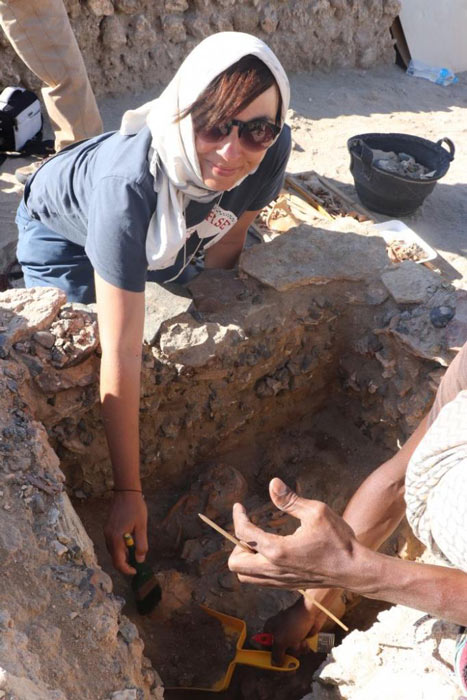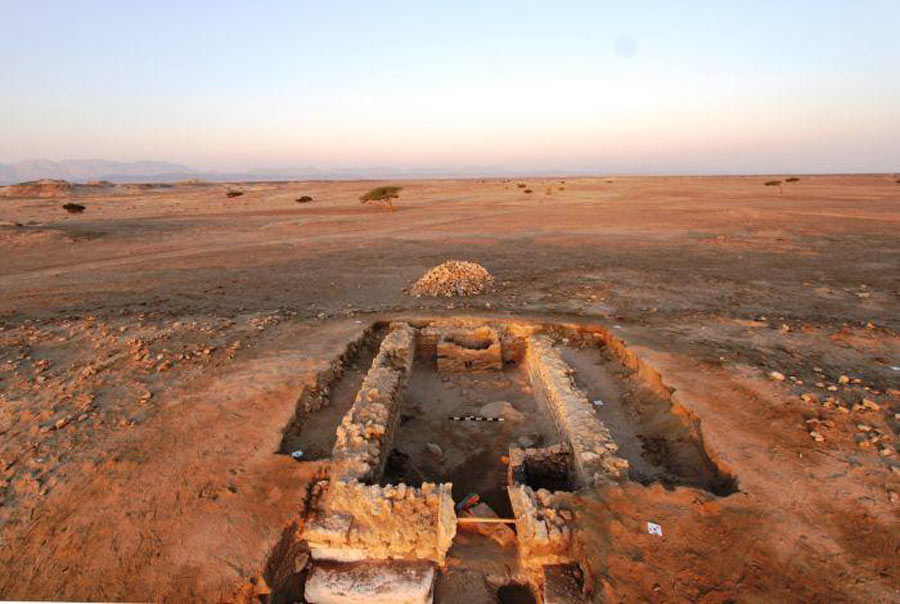Strange ‘Huddled’ Skeletons Discovered in Berenice Troglodytica Tombs
Berenice Troglodytica, also known as Baranis, was a fledgling port city on the Red Sea in ancient Egypt. The remains of seven “huddled” skeletons in a tomb complex have been discovered at Berenice Troglodytica by Polish archaeologists, reports PAP. These seven individuals were buried in stone boxes with the bones of the lower limbs resting on the chest, which the archaeologists said was an extremely unusual burial method. The skeletons were located in several layers of different strata at the tomb complex, which has been dated to 1500 years ago.
Berenice Troglodytica And Its Links To Trade Routes to India
“This is not a natural position. In order to achieve it, the deceased had to be bound with ropes or tied with cloth," said Dr. Mariusz Gwiazda, from the Center of Mediterranean Archeology of the University of Warsaw, who led the Berenice Troglodytica research team. The rope would have been tied around the neck and legs, causing the body to fold against itself. One of the burials was a mother and child almost folded into each other. The burial goods and artifacts found in these tombs were clear evidence that the deceased were elite members of this society.
- Vast Roman-Period Emerald Mines Revealed in Egyptian Desert
- Blemmyes: The Headless Men of Ancient and Medieval Mythology
Dr. Gwiazda’s primary area of research is Berenice Troglodytica, along with Prof. Steven Sidebotham from the University of Delaware in the USA. Interestingly, after studying the accounts of Agatarchides of Cnidus, who was a Greek historian and philosopher in the 2nd century BC, Dr. Gwiazda was able to contextualize this find. Agatarchides described the funerary customs of the tribes of the Eastern Desert, adding that strings were tied around the neck and legs of the deceased so that the body would assume a crouching position. “Perhaps it was the same in this case,” said Dr. Gwiazda, according to the PAP report.

These finely worked carnelian beads were found in one of the Berenice Troglodytica tombs and clearly point to elite status and long-distance trade. (M. G. Gwiazda / Center of Mediterranean Archaeology of the University of Warsaw)
The high social status of the deceased was gauged from raw materials that had made their way to Berenice from modern day Pakistan, India, and the islands of Indonesia. This included intricately worked onyx and carnelian beads, along with ivory rings (from the Egyptian-Sudanese border), earrings, and silver bracelets. The deceased were placed in four distinct layers, with one under the other, though it is too early to know whether these burials were all at once or at different time periods. Similar tomb fittings from this era were found in Upper Egypt and Nubia, including a similar style of architecture.
Berenice Troglodytica was inhabited by the Blemmyes between the 4th and 6th centuries AD, who were a nomadic Nubian tribe of the mountainous Eastern Desert area. The Blemmyes had gained independence from the other Mediterranean empires of the time, by controlling the area east of the Nile (between modern-day Ethiopia and Berenice Troglodytica).
Trade flourished at this time, as the Nubians acted as intermediaries between the Byzantines and the communities of the Indian Ocean region (as the elite burial goods clearly reveal). In this period, a general air of prosperity and peace existed across the region and along the Red Sea.

One of the Berenice Troglodytica project archaeologists excavating one of the seven elite tombs recently discovered at the site. (M. G. Gwiazda / Center of Mediterranean Archaeology of the University of Warsaw)
Revealed: The Unusual Burial Habits of Non-Egyptian Peoples
“The burial habits of the community of Berenice have been shrouded in mystery until now. We wanted to fill this gap,” Dr. Gwiazda stated. What counted in their favor was the fact that the tomb was unplanned, which is a break from the ancient funerary customs identified in Egypt so far. In fact, Egypt is renowned for its elaborately planned burials, particularly in the case of the elites.
Berenice Troglodytica was initially established in the 3rd century BC by Ptolemy II and used primarily as a transfer point for the Roman importation of African elephants. Four centuries later, the Romans again took control of the Berenice trade center and made it part of the trade routes linking north Africa, Western Asia, and India.
The same excavations also provided the researchers with evidence of ancient funerary rituals. A platform with animal remains - the vertebrae of sacrificial goats or sheep - were found at the site. The platform had multiple bowls for offerings, and several upside-down amphorae, which were used during rituals. Small water storage bottles that keep the temperature inside the bottle cool, used by the Arabs, were also found on the same platform.
The biggest takeaway from these discoveries is that we are learning more about the other peoples of this region, instead of focusing only the Greco-Roman and post Roman elements of Berenice Troglodytica. Until now, almost nothing was known about the Blemmyes at Berenice, including their lifestyles and burial habits. But now we know more.
- Berenice Fortress Well Speaks of Volcanic Apocalypse
- Asian and Nubian Influences Found In Ptolemaic Era Statues in Berenice

More beads discovered inside a tomb near Berenice Troglodytica. (M.G Gwiazda / CAŚ/ PAP)
A few years ago, an amazing animal cemetery dating to 2,000 years was found at Berenice Troglodytica. Apparently, monkeys were brought from India, paraded around as mascots, and then buried on the edge of the city. Similar burial treatments were meted out to dogs and cats as well.
Excavations conducted in 1994 revealed Berenice Troglodytica directly received cargo from India’s Malabar Coast, Sri Lanka, and the Indian Tamil region, who were some of the earliest traders at Berenice. More about the fascinating history of this fledgling outpost will certainly be uncovered as the Polish research project continues.
Top image: The tombs of the seven elites buried in a strange, crouched position were found in this tomb complex near Berenice Troglodytica by Polish archaeologists. Source: M. G. Gwiazda / Center of Mediterranean Archaeology of the University of Warsaw / PAP
By Sahir Pandey
References
Altuntaş, L. 2022. 1500-year-old Elite tombs were discovered vicinity of the ancient seaport of Berenice Troglodytica in Egypt. Available at: https://arkeonews.net/1500-year-old-elite-tombs-were-discovered-vicinity-of-the-ancient-seaport-of-berenice-troglodytica-in-egypt/.
Heritage Daily. 2022. Monumental tomb complex discovered in Berenice Troglodytica. Available at: https://www.heritagedaily.com/2022/05/monumental-tomb-complex-discovered-in-berenice-troglodytica/143665.
Zdzieśmieowski, S. 2022. Egypt / Elite grave from before 1.5 thousand. years were discovered by archaeologists in Berenice. Available at: https://naukawpolsce.pl/aktualnosci/news%2C92395%2Cegipt-elitarny-grob-sprzed-15-tys-lat-odkryli-archeolodzy-w-berenike.html.

















